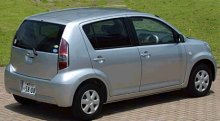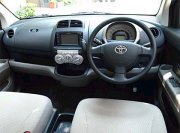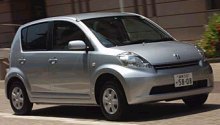|
 If
the 1999 Yaris was a statement of style, the 2004 Passo must be a
statement
of practicality. Its exterior design is neither pretty nor elegant. Its
cabin design is uninspiring. Plastic quality is average. It innovates
nothing.
It does not set any new standard in any areas. Nevertheless, it is
undoubtedly
a practical, easy-living hatchback. Its squarer shape provides plenty
of
interior space, so is the long wheelbase that exceeds Yaris by 70mm.
Four
large doors enables the passengers to access conveniently. A huge and
wide-opening
tailgate aids luggage access. Rear seats fold flat to form a flat load
area. A pair of simple hooks allow 2 tilt angles for the rear
seatback…. If
the 1999 Yaris was a statement of style, the 2004 Passo must be a
statement
of practicality. Its exterior design is neither pretty nor elegant. Its
cabin design is uninspiring. Plastic quality is average. It innovates
nothing.
It does not set any new standard in any areas. Nevertheless, it is
undoubtedly
a practical, easy-living hatchback. Its squarer shape provides plenty
of
interior space, so is the long wheelbase that exceeds Yaris by 70mm.
Four
large doors enables the passengers to access conveniently. A huge and
wide-opening
tailgate aids luggage access. Rear seats fold flat to form a flat load
area. A pair of simple hooks allow 2 tilt angles for the rear
seatback….
 Passo
has a twins sister named Daihatsu Boon. They are the first joint
venture
between Toyota and its subsidiary Daihatsu. Basically, they are the
same
car with just the slightest deviations in packaging. To Toyota, Passo
slots
in the space under Yaris to be the company's bottom of the range. On
the
contrary, Boon replaces Sirion (Storia) to be Daihatsu's top model.
According
to insiders, the twins were basically engineered by Toyota but the
interior
packaging was developed by Daihatsu taking advantage of its
small-car-big-interior
know-how. Passo
has a twins sister named Daihatsu Boon. They are the first joint
venture
between Toyota and its subsidiary Daihatsu. Basically, they are the
same
car with just the slightest deviations in packaging. To Toyota, Passo
slots
in the space under Yaris to be the company's bottom of the range. On
the
contrary, Boon replaces Sirion (Storia) to be Daihatsu's top model.
According
to insiders, the twins were basically engineered by Toyota but the
interior
packaging was developed by Daihatsu taking advantage of its
small-car-big-interior
know-how.
The Passo
has the
same length
and width as Yaris, raising concern whether it will create internal
competition.
However, Yaris is 5 years old now and I expect the next generation will
grow in size again to avoid competition with Passo. Moreover, Yaris
will
have better styling and higher quality packaging to ask for a higher
price.
Therefore the lean Passo will be Toyota's cheapest model.
 Apart
from a lower price tag, the Passo is also designed to be cheap to run.
It employs a pair of newly developed engines. The base engine is a
1.0-litre
VVT-i three-cylinder. Using one fewer cylinder helps it to achieve
lower
thermal and frictional loss hence it can return more miles per gallon
of
fuel. Its character is smooth, lively and surprisingly powerful, if
noisy
at high rev. Another engine is a new 1.3-litre VVT-i four-cylinder,
with
longer stroke and smaller bore than the Yaris' unit to enhance torque
and
fuel efficiency. Apart
from a lower price tag, the Passo is also designed to be cheap to run.
It employs a pair of newly developed engines. The base engine is a
1.0-litre
VVT-i three-cylinder. Using one fewer cylinder helps it to achieve
lower
thermal and frictional loss hence it can return more miles per gallon
of
fuel. Its character is smooth, lively and surprisingly powerful, if
noisy
at high rev. Another engine is a new 1.3-litre VVT-i four-cylinder,
with
longer stroke and smaller bore than the Yaris' unit to enhance torque
and
fuel efficiency.
The chassis of
Passo has
nothing exciting. It gets the usual suspension design and the usual
Japanese-style
tuning. In other words, priority is put on ride comfort instead of body
control. If you push it into corners, you will find it rolls and
understeers
more severely than European hatchbacks. Besides, the steering is also
set
to the light side, opposing to the taste of keen drivers. At the
current
setup, Passo is not going to please car enthusiasts. However, once it
is
exported to Europe - more likely to be in Daihatsu form - it will
undoubtedly
get some treatment. But even so, it is not going to attract many
attention.
The point is, Passo lacks a clear character to distinguish itself from
countless of other fine superminis. |